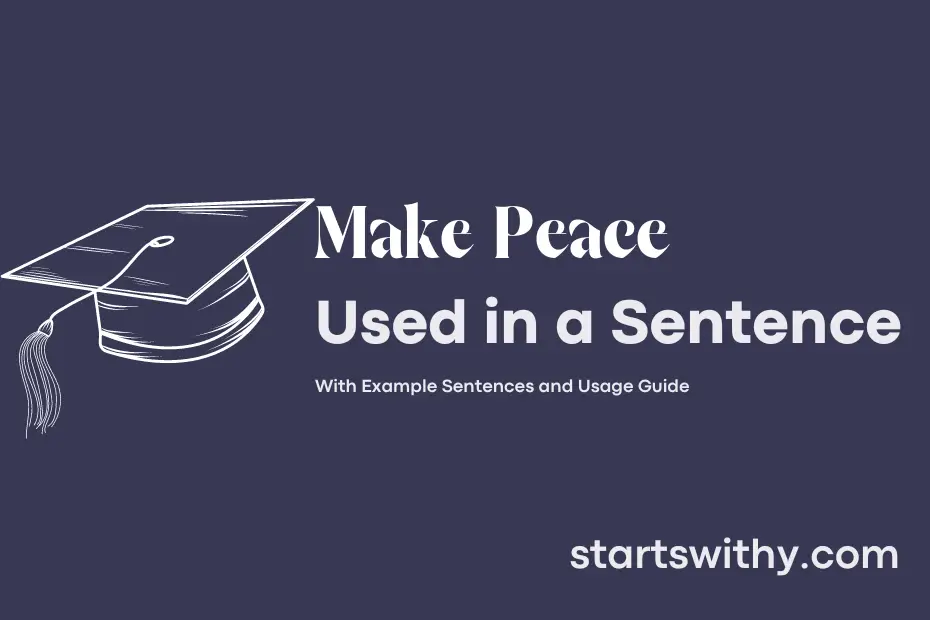Have you ever heard of the term “make peace”? Essentially, making peace involves resolving conflicts or differences in a calm and harmonious manner.
When individuals or groups choose to make peace, they actively work towards finding mutually beneficial solutions and letting go of animosity. It is about fostering understanding, forgiveness, and cooperation to create a peaceful and positive resolution.
7 Examples Of Make Peace Used In a Sentence For Kids
- We can make peace by sharing our toys with each other.
- Let’s hold hands and make peace with our friends.
- Saying sorry when we make a mistake helps us make peace.
- We can draw pictures of peace to make peace in our hearts.
- Smiling and saying kind words can help us make peace with everyone.
- Taking turns while playing will make peace among us.
- A big group hug can make peace after a disagreement.
14 Sentences with Make Peace Examples
- Make peace with your classmates before group presentations to ensure a smooth collaboration.
- After a disagreement during a debate, take a moment to make peace with your opponent to maintain a respectful academic environment.
- Make peace with your roommates by having open and honest discussions about shared responsibilities.
- Whether it’s over food in the mess or a borrowed textbook, always try to make peace with your friends to avoid unnecessary conflicts.
- During exam season, it’s important to make peace with your study habits and find a balance between work and relaxation.
- When working on group projects, be sure to make peace with differing opinions and find common ground for successful collaboration.
- If you accidentally offend someone with a cultural misunderstanding, take the time to make peace and educate yourself on their perspectives.
- Make peace with your past mistakes by learning from them and using them as opportunities for personal growth.
- In a competitive academic environment, it’s essential to make peace with rejection and keep striving for your goals.
- It’s important to make peace with your parents’ expectations and communicate openly about your academic choices and goals.
- When feeling overwhelmed by assignments and deadlines, take a step back to make peace with your schedule and prioritize self-care.
- After a heated discussion during a student council meeting, it’s crucial to make peace with your peers and find common goals for the future.
- When experiencing writer’s block while working on an essay, take a break to make peace with your creative process and come back with a fresh perspective.
- In moments of stress before exams, remember to make peace with your mind and practice mindfulness techniques for mental well-being.
How To Use Make Peace in Sentences?
To properly use Make Peace in a sentence, you should ensure that the phrase is used in the correct context.
Here is an example of how to use Make Peace in a sentence:
- Example: After years of feuding, the two families finally decided to make peace and put their differences aside.
In this sentence, Make Peace is used to indicate the action of resolving a conflict or disagreement, and finding a way to be in harmony with someone.
When using Make Peace in a sentence, it is essential to remember that it typically involves two parties coming to a resolution or agreement, rather than just one person. It indicates a shift from conflict or tension to a state of understanding and agreement.
Additionally, it is important to note that Make Peace is a transitive verb, so it requires an object to complete the sentence. The object can be a person, group, or even a situation.
By following these guidelines and understanding the context in which Make Peace is used, you can effectively incorporate it into your writing or speech to convey the message of reconciliation and harmony.
Conclusion
In conclusion, making peace is essential for fostering harmony and understanding among individuals and nations. Simple acts of kindness, listening, and forgiveness are powerful ways to make peace and resolve conflicts. By practicing empathy and embracing compromise, people can overcome differences and work towards reconciliation.
Ultimately, the ability to make peace lies within each person’s ability to set aside differences and strive for mutual understanding. Through open communication, respect for diverse perspectives, and a willingness to find common ground, individuals can build bridges and create a more peaceful world. It is through small gestures and meaningful actions that true peace can be achieved, leading to a more compassionate and unified global community.



